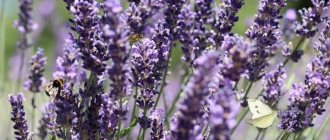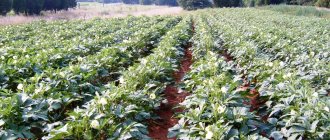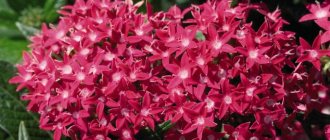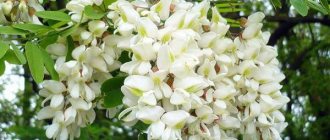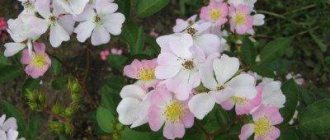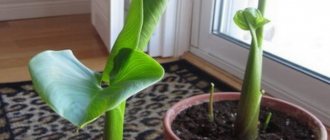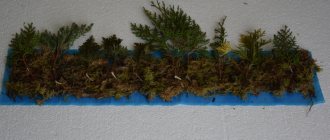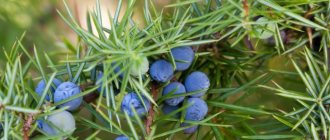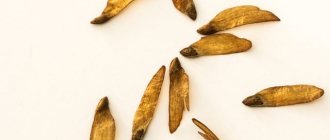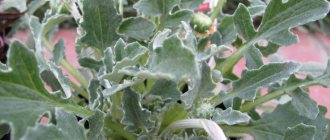Description of Albizia
This is a medium-sized tree, growing up to 10 m in height. It belongs to deciduous heat-loving plants, the habitat of which stretches from China, Japan and Southern Europe to the tropics of South America.
Source: Depositphotos Albizia is called silk for the delicate and smooth stamens of the flower
Albizia Lankaran is used for landscaping gardens, parks, and public gardens. Its wide crown provides dense shade, and the flowering period lasts from early July to October. No varieties have been developed that are grown indoors.
Botanical description of Albizia:
- umbrella-shaped crown;
- leaves are openwork, up to 20 cm in length;
- the flowers are white-yellow, with pink stamens, collected in corymbs;
- average life expectancy is 70 years.
During the flowering period, the crown of the tree resembles an umbrella, densely decorated with shiny pink inflorescences. There can be buds, flowers and young beans on the tree at the same time. Inside the fruit there are large peas up to 1 cm in diameter. They often self-seed.
In autumn, when the fruits ripen, the tree also looks decorative, as its 20-centimeter beans hang in clusters from the branches. In mid-autumn the foliage turns brown and falls off.
Symptoms of improper care
Sometimes the plant does not bloom and looks unhealthy. There are several main signs of poor health in silk albizia:
- Dropping unopened flowers. The reason is underwatering the plant. It is necessary to water more often, not allowing the top layer of soil to dry out.
- Fading, blanching of vegetative parts. The reason is a lack of nutrients, improper watering, and lack of lighting. Replant in new soil with good aeration, constantly moisten the soil without stagnating water. Move the flower to a more illuminated place.
- Drying of leaves along the edges and at the tips. The reason is too dry air, possibly from heating devices. The plant should be sprayed and moved away from the battery.
- Dark spots on leaves. The reason is incorrect air temperature, drafts. It should be removed away from the windows, not placed next to the door.
Caring for calathea at home: planting and methods of propagation
The lacy foliage of Albizia and the spicy aroma of its inflorescences will create a unique atmosphere in your home. Not even the most experienced gardener can cope with this unpretentious plant; the main thing is to ensure proper watering and a sufficient amount of light.
Features of cultivation
Silk acacia is a fast-growing tree. In one summer season, a seedling 20-30 cm in height grows from one seed. Proper cultivation of albizia involves following the recommendations:
- sowing seeds in April - May;
- seeds are poured with hot water and left for 1-2 days to swell;
- the soil is prepared light, neutral.
In the southern regions they are sown in open ground. Choose a sunny, open place. Replant the acacia to a permanent place only in the 2nd year of life. The plant does not tolerate transplantation well after reaching 6-8 years of age.
Water young seedlings regularly in the first year of life. If in winter there is a possibility of frosts down to -10 °C, cover the trees with non-woven material such as spunbond.
Mature trees tolerate drought and short frosts and do not require maintenance.
If the plant is grown indoors, one seedling needs a 5-liter pot with a drainage layer of 5-7 cm. The young plants are selected for a south-facing window and watered as the soil dries. The young tree is planted in natural conditions in the 2nd year of life.
Silk bush increases soil fertility as it enriches it with nitrogen. If the tree's crown is too wide, it can be trimmed. This procedure will make the tree even more magnificent and dense, and next year it will bloom more profusely. The growth-restraining pruning allows silk acacia to be grown in compact garden plots.
Planting Robinia
The choice of location for planting a robinia seedling is determined by the plants’ need for light. Natural protection from the north wind is also desirable for pink robins.
All robins should be planted in the spring, before buds open. The fact is that during autumn planting, the soil is too cold for the growth of the roots of these heat-loving plants and too wet, which is why the roots damaged during digging immediately begin to rot. In no case should you plant robins too deep - all because of the same danger of damping off. The ideal soil quality is a combination of sand and compost with the obligatory addition of some alkaline substance - ash, dolomite flour, old slaked lime, crushed limestone.
In general, these plants thrive much better on poor but loose soils than on rich and clayey soils. When planting on a clay area, you can try, as when growing stone fruit crops, planting on a mound, when the surface of the tree trunk circle, after settling, is above the soil level.
Features of Robinia
- Life form - Tree.
- Size - Height 20-25 m, width 12-20 m, trunk diameter up to 1.2 m.
- Crown - Openwork rounded.
- Leaves - Unpaired, 20-30 cm long, light green, poisonous.
- Flowering - In May-June, the flowers are white, fragrant, collected in racemes 10-25 cm long.
- Fruits - Beans up to 12 cm.
- Growth characteristics - Annual growth from 20 cm to 1 m at a young age.
- Durability - Up to 100 years.
Attitude:
- to the light - photophilous;
- to the soil - not demanding, but prefers light soils, tolerates salinity;
- for moisture - moderate watering;
- to the wind - not wind resistant;
- to temperature - frost-resistant.
Urban conditions - Smoke and gas resistant.
Decorative - Decorative during flowering.
Application - As a single tree, group plantings and alleys, it can strengthen soil on slopes.
Robinia pseudoacacia
Albizia julibrissin
Syn: silk albizia, silk acacia, Lankaran acacia, silk tree, silk bush, gul-ebrishim.
Albizia Lankaran is a heat-loving deciduous honey plant of the Albizia genus, legume family. In folk medicine it is used as an anti-inflammatory agent for external and internal use, and also has anthelmintic properties.
Table of contents
Flower formula
In medicine
Albizia Lankaran is not a pharmacopoeial plant and is not used in domestic official medicine, but in folk medicine of those countries where Albizia comes from, infusions and decoctions from different parts of the Albizia plant are used everywhere.
Teas made from silk acacia flowers are drunk to relieve stress, insomnia, sclerosis, and tightness in the chest. In addition, this tea improves digestion, heart function, and stimulates intestinal motility.
Tannins contained in Albizia bark have a positive effect on inflammatory diseases of internal organs (gastrointestinal tract, respiratory and genitourinary systems), as well as external inflammation (carbuncles, abscesses, abscesses).
Contraindications and side effects
Contraindications for the use of decoctions or infusions of albizia are pregnancy, all acute conditions, lactation, and childhood.
Article on the topic: Daurian hawthorn description and features
In gardening
Albizia Lankaran is most often used in gardening and landscape design. As an ornamental plant, the Albizia Lankaran tree is planted along roads, in parks, in summer cottages and in city parks. Silk Albizia grows up to 100 years and can reach up to 35 meters in height. Albizia Lankaran blooms for several months (usually from July to October), has large fluffy pink flowers, openwork foliage and a spreading crown. Due to their decorative qualities, such varieties of Lenkoran albizia as 'Jjulibrissin', 'Mollis', 'Tinkle Bell's', 'Summer Chocolate' are especially popular in gardening.
In other areas
The wood of Albizia Lankaran, like the wood of acacias related to Albizia, is used in the woodworking industry. It has a high density, beautiful pattern and can be polished, due to which it is used in furniture production, but is not very popular in this area due to the lack of large reserves of raw materials.
Albizia Lankaran bark contains a large number of pigments, so it was previously used to dye wool and silk fabrics yellow and brown.
Classification
Albizia Lankaran (lat. Albizia julibrissin) is a deciduous species belonging to the genus of trees and shrubs of the genus Albizia, the legume family (lat. Fabaceae). In addition to Albizia Lenkoran, the genus Albizia has about 125 species of plants growing in tropical and subtropical regions.
Botanical description
The average height of the plant is 6-9 meters, but individual specimens can reach 12 and even 30 meters. The Albizia Lankaran tree has a spreading umbrella-shaped crown with a diameter of up to 7 meters.
The unpaired, double-pinnate leaves of Albizia Lankaran consist of 9-14 lobes, reach a length of up to 20 cm, and have from 15 to 60 leaflets on each lobe. The leaf color is light green above, bluish below, with the exception of certain varieties that may have brown leaves (for example, the “Summer Chocolate” variety). In unfavorable weather conditions and at night, the leaves fold along the midrib, after which the entire leaf droops.
The flowers of Albizia Lankaran are collected in large fragrant paniculate inflorescences with five-ray symmetry. They have many long stamens of whitish-yellow or pink stamens protruding from the small white-yellow floral integument.
Albizia blooms from mid-June (July-August, depending on the climate), sometimes flowering continues until September-October. Formula of Albizia Lankaran flower: ♀♂ ↑Х5Л1+2+(2)Т(9)+1П1. The leaves remain green for a long time and fall off only after the onset of cold weather. The fruit of Albizia is a flat, oblong, multi-seeded bean, up to 20 cm long.
It has a powerful, shallow root system. A light-loving, fast-growing tree that can live 50-100 years. It usually does not tolerate frost well, but there are cases where the tree has withstood frosts down to -15-16°C. Propagated by cuttings, layering and seeds.
Spreading
Albizia Lankaran is widespread in tropical and subtropical latitudes, mainly in the Eastern Hemisphere: in southern Europe, China, Japan, Taiwan, India, Nepal, Iran, Afghanistan, Pakistan. Recently, Albizia is increasingly being bred for decorative purposes in the Western Hemisphere.
On the territory of the former USSR, Albizia Lankaran grows in the south of Azerbaijan in the Talysh Mountains, in the Crimea, as well as in the countries of Central Asia.
Procurement of raw materials
Albizia Lankaran flowers are harvested at the end of May or early June, at the beginning of the flowering period. The bark is also collected in summer and autumn in dry sunny weather and cut finely. The raw materials are dried outdoors in the shade or in well-ventilated dry rooms. It is necessary to dry the raw materials immediately after assembly to preserve all beneficial properties.
Collected and dried albizia flowers must be stirred from time to time so that they do not lose their aroma and beneficial properties. In addition to flowers, buds of Albizia Lankaran are also collected, picked in May (before they bloom) and dried in the open air.
Chemical composition
The bark of Albizia trunks contains saponins, tannins, triterpenoids (julibrosides A1, A2, A3, A4, B1, C1, julibrotriterpenoid lactone A, machaeric acid); nitrogen-containing compounds (hydroxy(hydroxymethyl)methoxymethyl-2-methylpyridin-O-glucopyranoside); phenol derivatives ((3,4,5-trimethoxyphenyl)-O-β-D-apiofuranosyl -(1® 6)-β-D-glucopyranoside) and phenol carboxylic acids (methyl ester-O-[O-β-D-apiofuranosyl -(1® 2)-β-D-glucopyranosyl]syringic acid); lignans (lioresinol-O-(O-glucopyranosyl-glucopyranoside, glaberide-O-[O-β-D-apiofuranosyl-(1® 2)-β-D-glucopyranoside], 5´,5´-dimethoxy-7-oxolariciresinol -4´-O-[O-β-D-apiofuranosyl-(1® 2)-β-D-glucopyranoside]); flavonoid (3,4´,7-trihydroxyflavone); steroid (a-spinasterol-O-β -D-glucoside).Aliphatic alcohol (isopentyl alcohol); aliphatic ketone (penten-4-one-2); amino acids (S-(β-carboxyethyl)-L-cysteine, albicine) and monoterpenoids (linalool, cis -linalool oxide, trans-linalool oxide, cymene).
Pharmacological properties
The medicinal properties of Albizia Lankaran are due to the tannins, amino acids, vitamins and other active substances contained in its bark and flowers. Infusions, decoctions, tinctures and teas from the flowers of the Albizia tree regulate the functioning of the nervous system, providing a sedative effect.
Related article: White sapota description and features
The active substances that make up the albizia bark also have a calming effect on the nervous system, improve blood circulation, heart and liver function. Due to the latter effect, infusions of Albizia Lenkoran bark can be used as a detoxifying agent. Some sources indicate the tonic, anthelmintic, wound-healing, anti-inflammatory, and analgesic effects of extracts from albizia.
Use in folk medicine
In folk medicine (especially in Eastern medicine), there are often recipes for medicines made from the flowers of Albizia Lankaran, as well as from the bark of this plant. Tinctures and teas are prepared from the dried flowers and buds of the tree, which are used to treat depression, melancholy, stress, insomnia and other nervous system disorders. In addition, teas made from Albizia flowers have a beneficial effect on digestion and eliminate flatulence.
Tinctures from albizia bark are used in folk medicine to treat delirium, insomnia, depression, inflammatory and purulent processes in the lungs, hemorrhoids and bone injuries (bruises, fractures and sprains). Albizia bark powder diluted in water (to a mushy state) is applied under a bandage for limb injuries, carbuncles, boils, tumors and abscesses.
Historical reference
The first part of the scientific name, Albizia, comes from the name of the Italian Filippo del Albizzi (Italian: Albizzi) from Florence, who brought albizia to Europe from Constantinople in the 18th century. The Latin name of the species “julibrissin” comes from the corruption gul-i abrisham (Persian گل ابریشم), which in Farsi means “silk flower” (from gul گل - “flower”, abrisham ابریشم - “silk”).
The Russian version of the name reflects the origin of the tree, whose homeland is Lenkoran (Azerbaijani: Lənkəran, read: Lankaran) - a region in Azerbaijan, which is known for the presence of ancient human settlements (from the Bronze Age).
Literature
1. A.I. Schröter, B.G. Valentinov, E.M. Naumova.
Directory “Natural raw materials of Chinese medicine” (in 3 volumes), volume I, Moscow, 2004.
2. Trees and shrubs of the USSR / P.I. Lapin. - M.: “Mysl”, 1966. - P. 423. - 637 p.
3. Gul-ebrishim // Encyclopedic Dictionary of Brockhaus and Efron: in 86 volumes (82 volumes and 4 additional). - St. Petersburg, 1890-1907.
Silk tree in landscape design
Winged euonymus, Fortune, European and other species
Albizia flowers and leaves are incredibly decorative; it is not surprising that the plant is often used in landscape design. The crown of the tree is not particularly dense, so you can grow various ornamental shrubs and light-loving flowers under it.
Note! Silk albizia leaves retain their bright green hue until cold weather.
Bright colors of Albizia Lankaran
What is unique about Lankaran Acacia or Silk Albizia?
Lankaran acacia has several names: silk albizia or silk tree. This unusual tropical plant belongs to the Legume family. It is often called Crimean mimosa.
Silk albizia can be of two varieties: tree or shrub. The tree is grown in open ground, and the bush is grown as a houseplant. Albizia is a heat-loving tree, so in harsh climates only the shrub form is grown.
Bush albizia at home can grow up to 3-6 m, and the tree sometimes exceeds 10-15 m in height.
The root system of both the tree and the bush is very strong, but superficial. Because of this, the plant can die even from the slightest frost. The acacia tree can be propagated by root shoots, which appear in large numbers in the fall.
The acacia trunk Due to climate change, the thickness of the trunk rarely reaches half a meter, although previously the diameter could be 80-90 cm. The bark is gray and cracks with age.
The flowers are very unusual, resembling a fluffy panicle. They are creamy white, with long pink stamens and purple tips.
The fruits of the plant are large bean pods, about 15-20 cm long. Each pod contains 8-9 large seeds.
The leaves are compound, fern-like, consisting of 14 small openwork, strongly dissected leaflets, light green in color. The leaf length is about 20 cm. At night, the leaves fold lengthwise and droop. With the onset of winter, the foliage completely falls off.
The stem of the flower is thick and short. The crown of the tree is spreading and umbrella-shaped. The shrub form of acacia is lush and dense.
Sowing seeds indoors
In open ground, Lankaran acacia is propagated by cuttings. Another way to propagate albizia is by growing it from seeds at home. First you need to prepare the containers and soil for planting. Tools and pots are disinfected with potassium permanganate, and the soil is warmed up. Expanded clay or river pebbles are poured onto the bottom of the container.
Growing pelargonium at home and caring for it
Composition of the soil mixture:
- 3 parts of turf land;
- 2 parts peat;
- 1 part sand.
Sowing is carried out in late February and until mid-July at room temperature +25°C. Before planting, the grains are soaked in warm water for 2-3 days. To make the sprouts hatch faster, the beans are carefully sawed, breaking their hard shell. Next, the seeds are planted to a depth of 4 mm and watered with a growth stimulator.
When seedlings of Albizia Lankaran, when grown from seeds, have true leaves, they are planted in containers with a diameter of about 8 cm. After the last frost, the seedlings are transferred to open ground, leaving gaps of about 2 m between plants. The place should be well lit, but at noon slightly shaded from the sun. A slightly acidic, light and nutritious substrate is desirable.
Care and planting of Lankaran Acacia
Silk acacia is a very heat-loving and drought-resistant plant. Planting in open ground is carried out in early May, in warm, sun-warmed soil, at a distance of 1.5-2 m from each other.
You can use the seedling method of growing. To do this, the seeds are sown in small cups to a depth of about 2-4 mm. When the seedlings grow well, they are planted in a permanent place. Seeds for seedlings can be planted in February-March. Related article: White mulberry description and features
The soil for acacia is fertile, sandy loam, with an admixture of lime. To plant indoor albizia, you can make the soil yourself. This will require turf soil, peat and sand. All this is taken in a ratio of 3:2:1.
The light regime for silk acacia is very important. She loves light, can withstand direct sunlight and does not tolerate shade at all.
Thermal mode. When growing albizia outdoors, the air temperature in summer should be about +25-27C, and in winter - no less than +8C. In some cases, it can withstand short-term frosts, but not lower than –10C. For indoor species, the temperature indicators are different: in summer – +20-25C, in winter – +5-7C.
Fertilizing can be done only in the second year after planting the plant. Special complex fertilizers are well suited for this. Feeding is carried out no more than once a month, and only during the growth period (May-July). In winter, the plant is not fertilized.
Acacias need infrequent but plentiful watering In winter, the plant is watered very rarely and little. Water for irrigation should be clean, settled and not cold.
Air humidity for indoor albition can be low or medium. It does not need spraying. When growing outdoors, you can spray occasionally, but not often.
Albizia blooms Flowers are excellent honey plants. The leaves remain on the tree until winter.
The smell of blooming acacia is very strong and pleasant, with bright notes of violet and raspberry.
pruned in early spring, before flowering. All diseased, old and dry branches are cut off. Remove excess, thickening shoots. This procedure can also be carried out after flowering has ended.
Reproduction of Lankaran Acacia . You can use seeds, root shoots or cuttings for planting.
Not all trees reproduce by root shoots. When roots appear protruding from the ground, they can be cut off, rooted and planted separately.
Any type of acacia, both indoor and outdoor, can be propagated by cuttings. The cuttings can be taken young or already lignified. It must have at least 2-3 buds. Can be planted without pre-soaking. The soil should be fertile, but not heavy. After a few months, most shoots take root.
The easiest way of propagation is by seed. Before planting, the seeds can be wrapped in damp moss and placed in the refrigerator for 1-2 months. Some gardeners prefer the hot processing method. To do this, the seeds are poured with very warm water for several hours and planted in the ground without deepening them. With this planting method, growth is very slow during the first year. There is no need to apply any fertilizers during this period. But regular watering is necessary.
The lifespan of silk acacia is about 50-70 years. The indoor species lives a little less, but with proper care it can bloom for a long time.
Growth rate . Starting from the second year of life, albizia begins to grow very quickly. When planted in open ground, after three years it can reach a height of 5 m. It grows for about 30 years, after which the aging period begins.
Growing albizia at home
Currently, the cultivation of silk tree as an indoor crop is not yet as widespread as an outdoor one. Although this is a tropical plant, it is not picky about its conditions. And if you know the peculiarities of growing Lenkoran acacia , planting and care, then it will reward you with its original flowering.
- Albizia grows well in bright light. The eastern and western sides are suitable for it; on a southern window in summer it is better to shade it a little from direct sunlight. In the summer, you can take the plant outside, initially covering it from the scorching sun.
- The optimal temperature for growing Lankaran acacia is +20…+25°C. During the rest period, maintain a regime of about +10°C. It should be taken into account that the silk tree is a deciduous plant, and do not worry about shedding leaves at this time.
- During growth, albizia should be well watered, but without stagnation of water in the soil. Since the root system is superficial, the top of the soil should also be constantly moist. During the dormant period, it is necessary to water the soil weekly. It is better to use settled water at room temperature.
- Acacia is fed from March to August, during the period of intensive growth. Fertilizers for decorative deciduous plants are applied every 15-20 days. During budding and at the beginning of flowering, you can use fertilizer with a high content of phosphorus and potassium.
Crimean mimosa does not require high humidity. The air of an ordinary apartment suits her quite well.
Diseases and pests
Garden Lenkoran acacia is almost not susceptible to disease and does not suffer from attack by pests. Indoor acacia can be affected by spotting when overcooled, and spider mites when humidity is low.
Pest Control
You can notice the appearance of a mite by the presence of reddish dots on the underside of the leaves. Later, the leaves become covered with a dense sticky web.
To get rid of this pest, it is necessary to increase the air humidity around the plant and wash the stems and leaves with a warm soapy solution. In case of severe damage, treatment with acaricidal preparations can help, but only at temperatures above +18-20C.
Treatment of diseases
Leaf spot is a bacterial disease. It's not difficult to deal with him. It is enough to tear off all the affected leaves and treat the plant with a fungicide. You can also use copper sulfate or Bordeaux mixture. During this period, watering is sharply reduced.
Caring for this unusual plant is quite simple. In the southern regions it can be planted in the garden. Lankaran acacia will decorate any area with its beautiful blooms and unique aroma. And indoor albizia will perfectly complement the interior.
Next you will see a photo of Lankaran Acacia:
Reproduction
Albizia can reproduce vegetatively and by seeds.
Cuttings, root shoots and layering are suitable as vegetative propagation methods for the plant.
Cuttings
The correct algorithm for propagating albizia by cuttings is as follows:
- In May, cuttings are taken from last year's stems.
- The length of each cutting must be about 10-15 cm, and several buds must also be present.
- The lower cut is made at an angle, and the upper one must be straight.
- All leaf plates are removed from the lower edge of the cutting, and at the top the leaves are cut to half their length.
- It is recommended to use growth stimulants - Kornevin and similar drugs.
- Rooting is carried out in loose soil - a peat-sand earthen mixture.
- Lighting should be diffused, and the air temperature in the room should be maintained at 15 °C.
Albizia cuttings require approximately 3 months to fully root.
Layerings
The plant is propagated by layering in the spring.
To propagate an indoor flower by layering, you need to bend 1 of the stems to the ground and fix it in this position, sprinkling it with soil on top.
The top of the shoot should be above the ground.
It is imperative to keep the soil moist.
The young plant is separated from the mother specimen after 1 year.
Basal shoots
Often, young stems appear around an adult plant, which are shoots from the main root system.
In the spring, they can be carefully separated from the mother plant and planted in a separate container.
